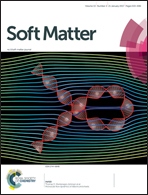Elasto-electro-capillarity: drop equilibrium on a charged, elastic solid
Abstract
We present a study here on elasto-electro-capillarity – for the first time, the matter of drop equilibrium on a soft (elastic and incompressible) and charged solid has been studied. Charges on the elastic solid induce an electric double layer or EDL at the solid–drop interface. Our analysis accounts for the electrostatic wetting contribution of the EDL in the overall energy balance. Our results reveal that (a) with an increase in “softness”, the equilibrium solid–liquid contact angles show transition from the EDL-modified Young's law (rigid limit) to the EDL-modified Neumann's law (soft limit); (b) the EDL effects invariably enhance solid deformation and lower the apparent contact angle made by the drop with the undeformed solid; (c) the solid contact angles increase and the cusp made by the deformed solid undergoes enhanced rotation due to the EDL effects; and (d) the EDL effects are more prominent for the case where the solid–vapor surface energy exceeds the solid–liquid surface energy. The fact that the EDL effects invariably decrease the overall wetting energy of the system, thereby supporting a larger increase in the elastic energy associated with a larger solid deformation, explains all these findings and establishes that surface charges enhance the “softness” of a soft surface in the context of elastocapillarity.



 Please wait while we load your content...
Please wait while we load your content...